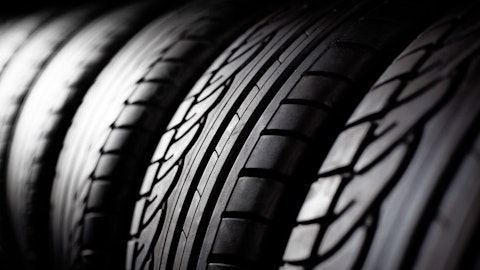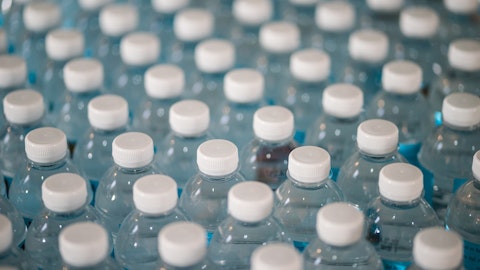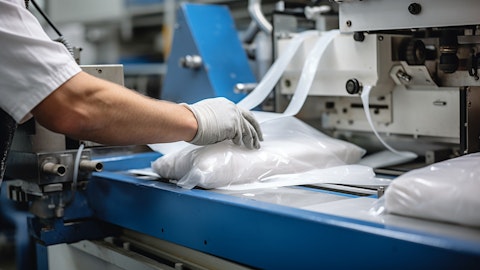Trinseo PLC (NYSE:TSE) Q4 2023 Earnings Call Transcript February 13, 2024
Trinseo PLC isn’t one of the 30 most popular stocks among hedge funds at the end of the third quarter (see the details here).
Operator: Good morning, ladies and gentlemen, and welcome to the Trinseo Fourth Quarter 2023 Financial Results Conference Call. We welcome the Trinseo management team, Frank Bozich, President and CEO; David Stasse, Executive Vice President and CFO; and Andy Myers, Director of Investor Relations. Today’s conference call will include brief remarks by the management team, followed by a question-and-answer session. The company distributed its press release along with its presentation slides at close of market Monday, February 12. These documents are posted on the company’s Investor Relations website and furnished on a Form 8-K filed with the Securities and Exchange Commission. [Operator Instructions] I’ll now hand the call over to Andy Myers. Please go ahead.
Andy Myers: Thank you, Audra, and good morning, everyone. At this time, all participants are in a listen-only mode. After our brief remarks, instructions will follow to participate in the question-and-answer session. Our disclosure rules and cautionary note on forward-looking statements are noted on Slide 2. During this presentation, we may make certain forward-looking statements, including issuing guidance and describing our future expectations. We must caution you that actual results could differ materially from what is discussed, described, or implied in these statements. Factors that could cause actual results to differ include but are not limited to risk factors set forth in Item 1A of our annual report on Form 10-K or in our other filings made with the Securities and Exchange Commission.
The company undertakes no obligation to update or revise its forward-looking statements. Today’s presentation includes certain non-GAAP measurements. A reconciliation of these measurements to corresponding GAAP measures is provided in our earnings release and in the appendix of our investor presentation. A replay of the conference call and a transcript will be archived on the company’s Investor Relations website shortly following the call. The replay will be available until February 13, 2025. Now I’d like to turn the call over to Frank Bozich.
Frank Bozich: Thanks, Andy, and welcome to our year-end 2023 earnings call. Although this was arguably the most challenging year in our company’s history and one of the most difficult in recent memory for the chemical industry, I’m proud of what we accomplished during the year to improve our cost position and strengthen our market position when global markets normalize. While unprecedented customer destocking, competitive pressure from imports into Europe and weak market demand persisted throughout the year, we didn’t sit idle. We took decisive action on items within our control to liberate cash improve profitability and extend our near-term maturities to provide ample runway for the continued shift of our portfolio. In the second half of 2023, we announced a series of additional restructuring actions, including the closure of our styrene facility in Terneuzen in the Netherlands, the consolidation of operations across our PMMA cast and extruded sheet network in Europe, as well as other cost savings measures.
In addition, we structurally reduced our working capital days to further preserve cash, and we expect to improve on these lower levels. We also successfully refinanced $1.1 billion in near-term maturities until 2028, which will allow us to continue advancing our market-leading sustainability program. These actions helped us generate positive free cash flow for the year despite the macroeconomic challenges we faced, resulting in $47 million of year-over-year increase in cash in our balance sheet. Regarding our sustainability investments, I would like to point out that we have remained focused on advancing our sustainability initiatives and working toward our 2030 sustainability goals. Through continued investment and significant advancements in our — made in recycling over the past year, we’re becoming a larger contributor to the circular economy.
We have commenced full operation in our polycarbonate dissolution pilot facility in Terneuzen in the Netherlands and recently announced the inauguration of our PMMA depolymerization plant in Rho, Italy, which is on track to be commissioned later this quarter. Once operational, this facility will be able to recycle a broad range of PMMA waste, including end-of-life PMMA, by reducing it back to its constituent monomer, MMA. These recycled monomers can then be used to produce PMMA resins, sheets and compounds containing recycled materials that will match the quality of virgin materials. In summary, this depolymerization facility will help promote a circular plastics value chain without compromising quality or performance. I am also happy to report the sales of our recycled content-containing products were up 16% year-over-year and we expect continued growth as our recycling operations mature, and we continue to develop new sustainable solutions for our customers for these high-demand offerings.
Additionally, our specialty and sustainable solutions technologies, which include most of our formulated technologies and engineered materials such as rigid compounds, PMMA resins, continuous PMMA sheets and TPEs, as well as case and battery applications in Latex Binders, continued to see stable margins and experience less volume decline than our commodity applications. From an EHS standpoint, I’m happy to share that 72% of our eligible sites received a Triple Zero Award this year, meaning the site achieved no injuries, spills or process safety events. This is a testament to the diligence that our people work on — work with on a daily basis, and I’m extremely proud of this industry-leading EHS performance. Now I’d like to take a few minutes to provide an update on our fourth quarter results.

As we expected, adjusted EBITDA was sequentially lower than Q3 as year-end customer inventory management and destocking led to a more pronounced seasonality than usual. We saw this dynamic throughout our value chains, but most predominantly in building and construction, appliances and consumer durable applications. However, we’ve already seen volume recovery early in the first quarter and expect sequentially better results, which I’ll discuss later. Now I’d like to turn the call over to Dave to discuss our fourth quarter and full-year results.
David Stasse: Thanks, Frank. Fourth quarter adjusted EBITDA was below our expectations due to pronounced seasonality and destocking, as well as $9 million of unfavorable impacts from natural gas hedges. However, we expect a significant rebound in Q1, which Frank will discuss in more detail. Our full year adjusted EBITDA results included unfavorable impacts of $51 million from natural gas hedges, $20 million from net timing and $13 million from fixed cost under-absorption related to our actions to reduce inventory. Despite the challenging macroeconomic environment that we endured throughout the year, we generated cash from operations of $149 million and a free cash flow of $79 million in 2023, which reflects the significant efforts by our organization to manage CapEx and working capital very tightly, realizing the benefits of our ERP and supply chain investments.
We released $250 million of working capital in 2023, and about two thirds of that is a structural reduction in days that we believe we can keep when market conditions improve. For the full year in 2024, we will continue to maintain a very disciplined cash focus with lower-than-historical CapEx of about $70 million as well as further progress in reducing our working capital days. While we expect a working capital release for the year, please keep in mind that working capital is likely to increase in Q1 due to seasonality. We ended 2023 with $259 million of cash and $471 million of liquidity, including our undrawn bank facilities. While we are comfortable with our cash and liquidity levels heading into 2024, we remain highly focused on opportunities that prioritize liquidity and profitability improvement while exercising disciplined working capital management.
Now I’ll turn the call back over to Frank.
Frank Bozich: Thanks, Dave. So far to begin the year, we’re seeing sequentially higher volumes in Q1 due to customer orders reflecting underlying market demand levels following the strict inventory management that we saw at the end of 2023. We’re also beginning to recover volumes in Europe that had been taken by imports from Asia. Additionally, starting in Q1, we expect to see the full benefit of the restructuring initiatives that we took in the second half of last year as well as much lower natural gas hedge losses. As a result, we expect Q1 profitability to be significantly higher than Q4, with adjusted EBITDA of about $40 million to $50 million. We view first quarter profitability as the low point of the year due to turnaround activity in the first quarter, seasonally lower volumes, non-recurring costs in Q1 and growth from new business awards that phase in later in the year.
In addition, we’re currently seeing higher input costs in several segments related to Red Sea shipping surcharges that we expect to fully recover in our prices in Q2. Please note that we don’t believe these higher sequential Q1 volumes represent a broad underlying market recovery, and for the full year, we currently anticipate underlying market demand to remain constrained and generally in line with 2023. Despite this, we expect higher volumes in our more specialty businesses as we recover share against Asian imports due to moderating cost in Europe and as we win new business in our target applications. In addition, we expect significantly higher profitability in 2024 as the restructuring actions we’ve taken combined with expected lower natural gas hedge losses are expected to contribute approximately $100 million of sequential benefit.
While we anticipate the logistics cost increase related to the Red Sea shipping crisis may help reduce cost differential between our European products and imports from Asia, it’s difficult to determine the impact of this at this time. Along with this, we have additional network optimization opportunities in Europe that we continue to explore, which we hope to benefit from later in 2024. I want to be clear that our strategy remains unchanged. Since the second half of 2022, our company has faced unprecedented challenges marked by persistent customer de-stocking throughout our value chains, along with geopolitical conflicts that have significantly impacted trade flows and the competitiveness of European chemical production. Amid this environment, we took decisive actions to increase our manufacturing network flexibility, which enables us to take advantage of regional cost differences while reducing capital expenditures and optimizing working capital.
And we will continue to assess additional opportunities. In fact, since 2022, we have reduced fixed costs by over $70 million while also offsetting inflation. These actions have improved profitability, cash flow, allowing us to continue investing in higher value product offerings and sustainable solutions and to be in a better position when demand returns to normalized levels. Lastly, I want to take a moment to thank our employees across the globe for their relentless efforts in 2023 and for the dedication to our transformation strategy as we continue to navigate this difficult macroeconomic environment. And now, I’m happy to take your questions.
See also 20 Most Reliable Cars For Seniors and Top 20 Most Respected Countries in Europe.
Q&A Session
Follow Trinseo Plc (NYSE:TSE)
Follow Trinseo Plc (NYSE:TSE)
Operator: [Operator Instructions] We’ll take our first question from Frank Mitsch at Fermium Research.
Frank Mitsch: Hey, good morning.
Frank Bozich: Good morning, Frank.
Frank Mitsch: Frank, you indicated that as we’re — thank you — as we’re sitting here in the middle of February, you indicated that you’re seeing sequentially higher volumes so far relative to the fourth quarter. And you also mentioned you’re getting a volume benefit in Europe due to less imports coming out of Asia. Can you be more granular in terms of the end markets that you’re seeing those impacts?
Frank Bozich: I would say it’s mainly in our specialty business applications in Europe, automotive and some of the building and construction applications. Some of the consumer products applications is where we’re seeing those volumes come back. But look, for — this is really for the first time in 20 months in January we saw year-over-year volume increases, and the order book in February looks similar. So I would say it’s clear two months don’t make a trend, but it’s — and I would say it’s too early to tell if this reflects the end of the stocking or some of this is from orders that shifted from Q4 to Q1. But again, it’s significantly better than Q4. But difficult to say that it’s a trend.
Frank Mitsch: Okay. All right. That’s helpful. And if I look at your Slide 13, where you list all the puts and takes in terms of cash flow components, that nets to about $300 million cash outlay in 2024. So how are you thinking about your ability to progress through the year based on your profitability levels in terms of will you have to draw down cash, will you have to borrow cash, or your expectation on profitability will more than exceed those puts and takes on cash from operations? I know it’s kind of early in the year to forecast that with the uncertain economic background, but I was just curious how you’re thinking about the cash generation or cash burn in ‘24?
David Stasse: Hi. Good morning, Frank, it’s Dave. I’ll answer that. So you’re right. We have a page in our slide deck 13, that shows our cash flow components for the year. And included in that is an estimated working capital benefit of $50 million. And we’ve got actions identified and already underway to realize that. So I’m confident we’re going to be able to achieve that working capital release again in 2013. So nonetheless, all of that adds up to $300 million — about $300 million of cash outlays. You’ll notice, obviously, that we didn’t give — we’re not giving annual guidance on this call because of the degree of uncertainty, the pretty significant lift in volume that we’ve seen. We need to see if that persists or not. But to the extent our EBITDA for the year is higher or lower than $300 million, that would be the positive or negative free cash flow for the year.
Now, what I would say related to drawing on lines, we ended the year with $260 million of cash on the balance sheet and we do have undrawn lines behind that for a total of almost $500 million of liquidity. We’ve not drawn on any of our lines. I don’t expect to need to. With what we generate this year, I think our work — we have plenty of cash on the balance sheet to — and if we do in fact have a negative free cash flow year this year, I would expect us to finance that with cash off the balance sheet and not drawing on lines.
Frank Mitsch: Sounds good. Just lastly, what is the kind of minimum cash level you feel comfortable with having on the balance sheet to run the company?
David Stasse: Yeah. I think the minimum level of cash, Frank, is about — look, the way I would define that minimum level, first of all, is how much cash you need to weather intra-month working capital swings, ups and downs. And I’d say that’s probably about $100 million.
Frank Mitsch: Very helpful. Thanks guys.
Operator: We’ll take our next question from David Begleiter at Deutsche Bank.
David Begleiter: Hey, good morning. Frank and Dave, you talked about Q1 being a low point of the year for a number of reasons. How should we think about the ramp to Q2?
Frank Bozich: In terms of what elements will contribute to a buildup in Q2, what I would say the drivers for that are normal seasonality in building and construction. We would always see those applications’ volumes improve in those end markets. The other significant impact that will go away in Q1 is that the AmSty turnaround is going to be over in Q1, and so we’ll have a full benefit of AmSty’s earnings contributions in Q2. And then we’ll see mid single-digit million per quarter EBITDA contributions from new business awards that will phase in, in subsequent quarters. You know the timing — I can’t predict exactly whether it will be in Q2 to Q3, but I would expect it to be mid single-digit contributions from those. The other thing that we’re seeing that’s somewhat depressing Q1 relative to what we expect in Q2 is the freight surcharges that we’re seeing related to raw materials that we source from Asia now coming from — are a couple of hundred dollars a ton higher due to freight, and that’s mainly in our plastic solutions value chain.
And we expect to recover that in pricing beginning in Q2 if it still persists.


